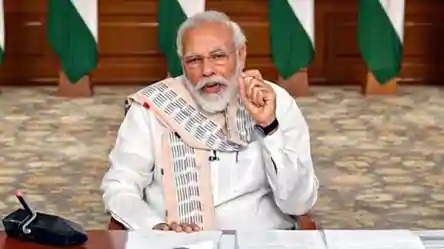The ‘Bharat’ Narrative - III
| Date :20-Jun-2020 |

By Vijay Phanshikar :
This is, in the nutshell, the story of the ‘Bharat’ narrative now firming up its roots in India’s official theory of nationalistic social revival, backed even by the leaders in the Government’s political, cultural and scientific establishments, lending it the status of a signature campaign of what Prime Minister Mr. Narendra Modi calls ‘New India’.

“Sangacchhadhwam Samvadaddhwam Sam Vo Manaasi Jaanataam/ Deva Bhaagam Yatha Purvey, Sanjananaa Upaasatey//” - Sandnyaan Suktam, RigVedic prayer (May all of us walk together, think together, speak the same thought together, and like what the gods and sages did in the past, enjoy the fruit of togetherness with effort ...) THIS prayer is collectively sung by people all over the world on the International Yoga Day as millions get engaged in Yogic exercises on June 21, indicating an essence of the ‘Bharat’ narrative, in which togetherness is the core value that underlines unified thought and action. When the ‘Bharat’ narrative occupies thought in India, this prayer assumes tremendous importance. The reason is not far to seek.
For, when the political and social leaders of the country thought of cleavaging the people on the lines of religion, caste, creed and ethnic communities, the quintessential ‘Bharat’ narrative was lost in the din. When that core value was forgotten, it was easy for vested interests to drive a divisive wedge through the society still deeper, hurting the sense of Indian identity. Deep and sincere research into history, culture and ethos of India has now revealed that the main -purpose of vested interests was to make the people forget the very foundation on which they based their socio-politico-cultural thought -- to emerge at the top of the global order for thousands of years.
The alien invaders took time to understand why Bharat -- India -- was such an almost undefeatable nation. But once they did that, they worked hard to destroy the Indian people’s sense of identity, unity, integrity, dignity. That effort of destruction was very well-planned, aimed at destroying the Indian system in totality. That effort began with a deadly theory that the people whom the world recognised as Arya actually did not belong to India and they were also invaders who came from outside and inhabited the land. Another deadly theory was that two races inhabited India historically -- the Aryans and the Dravidians (denoting people from North India and people from South India).
Yet another theory that was made to do the rounds was that Sanskrit was not a language as ancient as Indians believed, and had quite a recent origin. One more theory also was foisted on the enslaved Indian society -- that India was never one single nation and it attained nationhood only when the British united the country politically. If these were the deadly theories foisted on India, some dangerous policies also were imposed on the Indian society. One policy was aimed at progressive taxation on agriculture and the British used the money the Indians paid to take away from the country every possible grain of whatever resources the country had -- cotton, minerals, gold, silver, spices, steel implements.
All that was designed to render the country poor. So, in just about a hundred years, India was pushed into abject poverty. Then came the deadly effort to deprive the Indian society of its robust, time-tested system of education. Enough proof is available in the domain of unbiased history that Indian education was the best in the world, attracting countless thousands of foreign students to study at various university-level institutions spread across the land in astounding numbers. Those efforts also succeeded in giving the Indian people an impression that they were members of an illiterate society. All these theories and policies were designed to demolish the natural sense of pride and belonging the people of India felt for their history, tradition, ethos and culture, designed to implant an inferiority complex in their minds. But everything was so badly lost as some may feel reading this small description. For, even as the alien rulers made such attempts, a parallel movement also took birth and roots in the Indian society counter this anti-India narrative. Scholars and intellectuals who knew the Indian reality worked on a parallel track to counter the alien narrative successfully.
So, no matter how much effort the alien rulers might have put in to demolish the sense of Indian identity, this parallel movement kept the ‘Bharat’ narrative alive. This movement disproved the fake theories imposed on the society -- such as the Aryan invasion theory, or the Indian backwardness theory or the theory of Indian society being traditionally poverty-stricken -- economically or educationally. That was the success of the unstated ‘Bharat’ narrative. No matter what the British did, no matter what other invaders before them did, the larger Indian society never lost its sense of identity -- and remained resilient to the great Indian reality of history, tradition, ethos, culture, commerce, arts and sciences.
The people of India rejected all those fake theories, no matter what a few pseudo-intellectuals, pseudo-seculars and Left-liberals tried to achieve by pushing their own versions -- from the Tukde-Tukde gang in the Jawaharlal Nehru University to those who raised questions of integrity of India’s Armed Forces after surgical and air-strikes against Pakistan. This is, in the nutshell, the story of the ‘Bharat’ narrative now firming up its roots in India’s official theory of nationalistic social revival, backed even by the leaders in the Government’s political, cultural and scientific establishments, lending the thought the status of a signature campaign of what Prime Minister Mr. Narendra Modi calls ‘New India’. In other words, the ‘Bharat’ narrative is also a tribute to those named and unnamed people who kept the idea alive through hostile times.